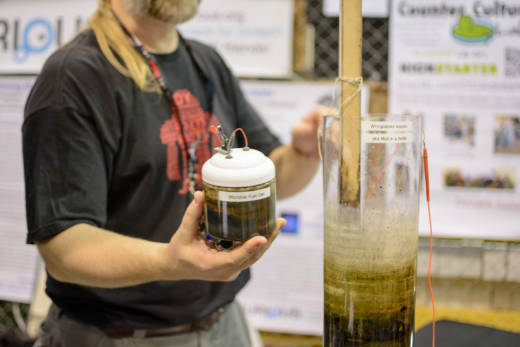I'd found Harness at a conference in Oakland billed as BioHACK THE PLANET, and told him my editor and I were particularly intrigued by a portion of Sunday's program titled "Bad things happen - are you prepared?"
Harness was unsurprised. That's what every member of the press wants to talk about, he said.
As it turns out, the subject is far less juicy than you might expect.
According to a 2013 survey titled "Seven Myths and Realities about Do-It-Yourself Biology" by the Woodrow Wilson International Center for Scholars in Washington, D. C., the vast majority of DIYers work with non-toxic, non-harmful organisms approved for biosafety level 1 research. Just like a high school lab.
Rather than working anonymously and solitarily, the report finds, DIYers overwhelmingly use group lab space. Many are still learning the basics of biology and don't have knowledge or tools of an advanced virologist. More importantly, lab directors keep an eye on all materials purchased, brought in, and removed from the lab, providing an obstacle to anyone trying to do secret nefarious "Frankensteinian" work.
Granted, it would be naive to suggest something couldn't go wrong. A workshop in August held by the Center for Global Security Research concluded that self regulation of community labs is working well so far, while also acknowledging that probability of an "unfortunate incident" increases as the DIY bio community continues to grow. (Read the workshop report.)
One idea under consideration is the creation of a "soft" safety licensing program for unaffiliated researchers, similar to amateur radio FCC licensing. Another recommendation from the workshop is that DIY labs create a code of conduct and establish relationships with local fire departments, public health officials and law enforcement.
Independent experimenters, working in their garages and kitchens, seem to trigger the greatest fears. And while these DIY-ers may fly under the radar (no one can control what you do in you garage after all), the report suggests we're probably more fearful that we need to be.
"Early narratives created by some writers and opinion-makers presented the notion of a lone 'biohacker' in a garage laboratory surreptitiously working with—or creating—dangerous pathogens," says the CGSR report. This is likely a "greatly exaggerated threat" the authors conclude, as it generally assumes amateurs in home labs can do what cannot yet be done by professional biologists in institutional settings.
Creativity, Unleashed
Patrik D'haeseleer, self-described "cat herder" at Counter Culture Labs, works a day job as a computational scientist at Lawrence Livermore National Laboratory.
"I've worked my whole career side by side with experimental biologists and I've always regretted not having the chance to build up that side of the skills as well," he told me. "So when I first heard about DIY bio I jumped on that. It's liberating. It's really energized my own career, because it opens up a field of creativity where I can just play around with things and try things out in the lab."
If he gets a cool idea on Saturday he might be working on it come Monday. In his professional career, he says by contrast, "at a very minimum it would be at least a year before we can actually work on it."
DIY biologists are currently working on such cool ideas as 'real vegan cheese' by coaxing baker's yeast into expressing milk protein. Someone is at work on an EpiPencil, which would cost $30, instead of the hundreds charged for an EpiPen. Others are working to develop more affordable generic medical treatments, such as insulin for diabetics, or estrogen for trans women. (Before reaching the market, these products would require normal regulatory approval.)
Eri Gentry, co-founder and president of BioCurious (she works a day job at Institute for the Future too), says she sees a current lack of investment in basic research and development. Her hope is to make biological research accessible to more people, broaden the playing field and spur more innovation.
"I'm hoping that we'll see more solutions for mankind," Gentry says.
Biotech will be the technology of this century D'haeseleer says. "It's going to affect our lives just as much or more as computers have."
D'haeseleer points to CRISPR, a gene-editing technique which has raised both widespread hope and alarms.
"To me, it's just a better screwdriver," D'haeseleer says. "There's lots of [good or bad] stuff you could do with a better screwdriver and it's probably those things you should be worried about and not the screwdriver."
